Kibbeh Soup

It is a wonderful Sephardi treat, kind of like, the Sephardi answer to the Ashkenazi Matza Ball Soup. They do share some trademarks: A clear Broth, and dumplings.
But Kibbeh soup is beet-based, hence its gorgeous deep ruby-red color. And the matzah balls are replaced with kibbeh.
Kibbeh are little bulgur meat pies.
It is a great Middle Eastern favorite; it seems everyone has adopted it as the darling ethnic dish. Served with a good crusty bread, it is a whole meal.
Traditionally, kibbeh are torpedo-shaped; the trademark oblong shape is undeniably adorable; flatten a piece of dough in your hand, place a little filling, then enclose the dough around the filling, and pinch the ends into points. Repeat. Fry.
Likewise, Kibbeh soup is a clear beet-based soup, with kibbeh thrown is after filling and shaping, unfried. The kibbeh soak up the lovely red color. Just so you do not feel cheated in any way, here is one of my favorite fried kibbeh recipes, abundantly illustrated to guide you every step of the way.
With Kibbeh as well as with Kibbeh soup, I am determined to bypass the individual filling, shaping and frying of each kibbeh: It is my guarantee that I will enjoy both a lot more often. And it is every bit as delicious. So my hacks are Baked Kibbeh, and this here easy deconstructed kibbeh soup.
Kibbeh Soup Broth!
Now if you ask me, the broth is the crux of this soup, just as it is the crux of matzah ball soup. My broth here is completely meatless, but the flavors are strong and resolutely umami. Once the kibbeh go in, of course the meat layer contained in the kibbeh runs into the broth.
Here I want to share not just one or two, but three very inexpensive secrets of fantastic all vegetarian and all natural broth: use them, and look like a pro!
Three very inexpensive secrets:
Kelp powder:
King of umami! The link I am providing here is for bulk amounts, because I use it constantly, not only in broth but also sprinkled in omelets, salad dressings, stews etc. Kelp is also called Kombu, and is most familiar in the shape of strips; it is most often thrown in broth liquids and imparts a wonderful seaweed flavor, with a slight bulk. I love to use it in powder form, because it disperses perfectly in the liquids.
Tamarind powder:
I couldn’t be without it! Read about tamarind’s origins and uses It is my best friend when I want to add an intense tart layer of flavor to broths, curries and sauces. It is also one of the secret (secret no more) ingredients in my dry spice rub
Kale Broth:
We all have on hands ribs and stems from bunches of dark greens we would rather not include in salads, because chewing on them seems very labored. We would all much rather be eating the raw leaves, and use the stems.
You will love my super simple Chicken Swiss Chard Tajine
On a regular basis, make a kale broth: Boil water with Kale ribs, Swiss chard ribs, and any other ribs you might have on hand, with 1 tablespoon of ground kelp powder, cook for about an hour, then remove all the ribs. You will be left with a broth so delicious that you will enjoy even drinking it as is, like a cup of tea.
Kibbeh soup freezes very well
Make the full batch, and freeze the uneaten portions.
Ingredients
Broth:
- 3 quarts (12 cups) water
- 2 tablespoons kelp powder
- 1 tablespoon tamarind powder
- 2 tablespoons turmeric
- 3 large beets, diced in 1-inch cubes
- salt to taste
- 1 tablespoon baharat
- 1/3 cup tomato paste
- Ribs from 1 large bunch red Swiss chard (reserve the leaves for last step), Plus any additional ribs you might have on hand: kale, collard greens, mustard greens
- 6 ribs celery
- 2 large red onions, skin and all, quartered
- 1 large bunch dill
- 1 large bunch parsley
- 1 3 inch piece ginger, cut in pieces
Quick Kibbeh:
- 1 cup bulgur
- 1 cup boiling water
- 1 1/2 cups ground lamb (settle for beef)
- 2 eggs
- 1 small red onion, quartered
- 1/4 cup toasted pine nuts, optional
- 2 tablespoons cinnamon
- 5 sprigs cilantro, tough stems discarded
- 6 sprigs flat parsley
- 6 sprigs mint, leaves only
- 1 tablespoon baharat
- the reserved red chard leaves, sliced into thin ribbons
Instructions
Make the broth:
Bring the first set of ingredients to a boil.
Put all the ribs, onion, dill, parsley and ginger in a large cheesecloth bag, and tie the ends securely.
throw the bag in the liquid, making sure it is immersed.
When the liquids reach boiling point, reduce the flame to medium and cook, covered, about 30 minutes.
Make the quick kibbeh:
While the broth cooks, make the kibbeh. Mix the bulgur with the boiling water, place in a glass or stainless steel mixing bowl (insisting on this: Do not use aluminum bowl), cover and let rest a few minutes. The bulgur will absorb all the liquid and, swell and get fluffy.
Add the lamb and the eggs to the bowl.
In a food processor, finely grind all remaining kibbeh ingredients. Add this ground mixture to the bulgur mixture, and mix thoroughly.
Form balls, and throw them in the cooking liquid. You will get about 3 dozen balls. Cover again, and cook another 30 minutes (Just to be clear: 30 minutes cooking before the kibbeh go in, plus 30 minutes after you throw them in. Total cooking time: 1 hour)
Finish the soup:
Remove the cheesecloth bag, pressing hard on the liquids first so as not to lose any of them.
Stir in the sliced leave.
Adjust texture and seasonings. If the kibbeh absorbed too much liquids, add a little water. You should be left with about 12 cups liquids.
Serve the broth with the beets, the leaves and the kibbeh.
Makes 8 ample servings.






